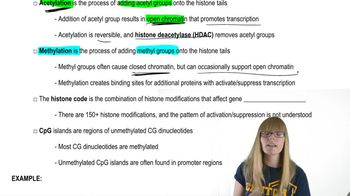Describe the molecular composition and arrangement of the components in the nucleosome.
Table of contents
- 1. Introduction to Genetics51m
- 2. Mendel's Laws of Inheritance3h 37m
- 3. Extensions to Mendelian Inheritance2h 41m
- 4. Genetic Mapping and Linkage2h 28m
- 5. Genetics of Bacteria and Viruses1h 21m
- 6. Chromosomal Variation1h 48m
- 7. DNA and Chromosome Structure56m
- 8. DNA Replication1h 10m
- 9. Mitosis and Meiosis1h 34m
- 10. Transcription1h 0m
- 11. Translation58m
- 12. Gene Regulation in Prokaryotes1h 19m
- 13. Gene Regulation in Eukaryotes44m
- 14. Genetic Control of Development44m
- 15. Genomes and Genomics1h 50m
- 16. Transposable Elements47m
- 17. Mutation, Repair, and Recombination1h 6m
- 18. Molecular Genetic Tools19m
- 19. Cancer Genetics29m
- 20. Quantitative Genetics1h 26m
- 21. Population Genetics50m
- 22. Evolutionary Genetics29m
7. DNA and Chromosome Structure
Eukaryotic Chromosome Structure
Problem 15
Textbook Question
Examples of histone modifications are acetylation (by histone acetyltransferase, or HAT), which is often linked to gene activation, and deacetylation (by histone deacetylases, or HDACs), which often leads to gene silencing typical of heterochromatin. Such heterochromatinization is initiated from a nucleation site and spreads bidirectionally until encountering boundaries that delimit the silenced areas. In the brief discussion of position effect, where repositioning of the w⁺ allele in Drosophila by translocation or inversion near heterochromatin produces intermittent w⁺ activity. In the heterozygous state (w⁺/w) a variegated eye is produced, with white and red patches. How might one explain position-effect variegation in terms of histone acetylation and/or deacetylation?
 Verified step by step guidance
Verified step by step guidance1
Understand the concept of histone modifications: Histone acetylation by histone acetyltransferase (HAT) is associated with gene activation, while histone deacetylation by histone deacetylases (HDACs) is linked to gene silencing. These modifications influence chromatin structure and gene expression.
Recall the concept of heterochromatinization: Heterochromatin spreads bidirectionally from a nucleation site until it encounters boundary elements. This spreading can silence genes located near heterochromatin regions.
Relate position-effect variegation (PEV) to chromatin structure: In Drosophila, the w⁺ allele's proximity to heterochromatin due to translocation or inversion results in intermittent gene activity. This leads to a variegated phenotype with red and white eye patches.
Consider the role of histone acetylation and deacetylation in PEV: Regions of heterochromatin are likely enriched in histone deacetylation, which silences gene expression. Conversely, areas of euchromatin with histone acetylation may allow gene activation, explaining the patchy expression of the w⁺ allele.
Propose a mechanism: The spreading of heterochromatin (via histone deacetylation) silences the w⁺ allele in some cells, while boundary elements or regions of euchromatin (via histone acetylation) prevent silencing in others, leading to the variegated phenotype observed in the heterozygous state.
 Verified video answer for a similar problem:
Verified video answer for a similar problem:This video solution was recommended by our tutors as helpful for the problem above
Video duration:
2mPlay a video:
Was this helpful?
Key Concepts
Here are the essential concepts you must grasp in order to answer the question correctly.
Histone Modifications
Histone modifications, such as acetylation and deacetylation, are chemical changes to histone proteins that influence gene expression. Acetylation, typically facilitated by histone acetyltransferases (HATs), is associated with gene activation by loosening DNA-histone interactions, allowing transcription factors access to DNA. Conversely, deacetylation, carried out by histone deacetylases (HDACs), often leads to gene silencing by tightening these interactions, promoting a more compact chromatin structure.
Recommended video:
Guided course

Histone Protein Modifications
Heterochromatin and Gene Silencing
Heterochromatin is a tightly packed form of DNA that is generally transcriptionally inactive, meaning genes located within heterochromatin are often silenced. This silencing is crucial for maintaining genomic stability and regulating gene expression. The formation of heterochromatin can be influenced by histone modifications, particularly deacetylation, which promotes a closed chromatin state, thereby preventing transcription of adjacent genes.
Recommended video:
Guided course

Mapping Genes
Position Effect Variegation
Position effect variegation (PEV) occurs when the expression of a gene is influenced by its chromosomal location, particularly when it is relocated near heterochromatin. In Drosophila, the w⁺ allele can exhibit variable expression levels, resulting in a mosaic phenotype of red and white patches in the eyes. This phenomenon can be explained by the varying degrees of histone acetylation and deacetylation at the gene's new location, leading to inconsistent activation or silencing of the gene.
Recommended video:
Guided course

Positional Cloning
Related Videos
Related Practice
Textbook Question
608
views


